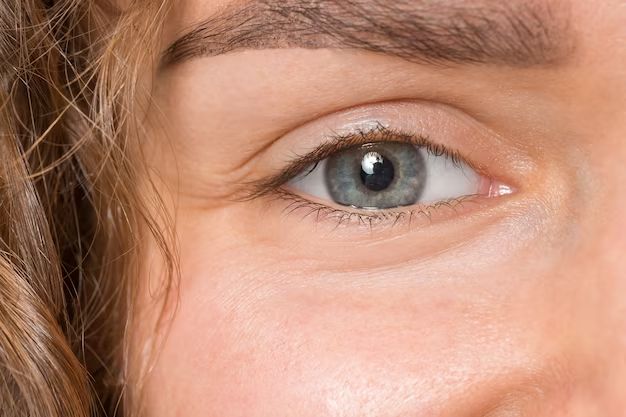Grey eyes are a fascinating eye color that can appear to change shades in different lighting conditions. This occurs because grey eyes contain low to moderate amounts of melanin pigment in the iris. The exact shade of grey eyes can range from light silvery-grey to dark charcoal grey. Many factors influence grey eye color, including genetics, lighting, emotions, and age. As people with grey eyes age, their eye color often undergoes some interesting changes.
The Genetics Behind Grey Eyes
Eye color is determined by the amount and type of melanin pigment in the iris. There are two main types of melanin:
- Eumelanin: A brown/black melanin that produces brown or black eyes
- Pheomelanin: A red/yellow melanin that produces green, hazel, amber, and light brown eyes
Grey eyes have small amounts of both eumelanin and pheomelanin in the iris, but not enough to make the eyes completely brown/black or green/hazel. This low concentration of melanin allows more light to scatter and reflect off the surface of the iris, creating a grey appearance.
The main gene involved in eye color is the OCA2 gene, which controls melanin production. Variations in this gene reduce the amount of melanin pigment made, leading to grey eyes. However, multiple genes influence eye color, so grey eyes depend on a unique combination of genetic variations that dial down melanin in the iris.
How Lighting Affects Grey Eyes
Grey eyes appear to change color based on lighting conditions. In bright sunlight, grey eyes can look almost crystal clear light blue or blue-grey. In dim lighting, the same grey eyes may appear darker grey, brown, or green. This is because different types of light can enhance or subdue the small amounts of color that exist in grey eyes.
Warm, yellow incandescent lights bring out hints of gold, brown, and green in grey eyes. Cool, white fluorescent lighting often makes grey eyes look more blue and grey. Natural daylight brings out lighter shades of blue and gray because it contains the full color spectrum of light.
The unique light-reflecting properties of grey eyes are what cause the illusion of color change. The low melanin content and transparent quality of grey eyes allows light toscatter through the iris and reflect back out. This makes grey eyes especially prone to looking different depending on lighting conditions.
How Emotions Change Grey Eyes
Our emotions can also influence temporary changes in grey eye color and appearance. Here’s how:
- Dilation of the Pupils: When we experience emotions like arousal, interest, or fear, our pupils dilate to let in more light. This enlarges and darkens the pupil, making grey eyes appear darker overall.
- Constriction of the Pupils: Constricted or narrowed pupils (from emotions like disgust or concentration) make the colored part of the iris more visible, enhancing the pale greys and blues of grey eyes.
- Tears: Watery eyes from emotions like sadness or joy make grey eyes look glassier and bluer by reflecting more light.
- Redness: Anger, crying, or physical irritation can cause bloodshot eyes, giving grey eyes a reddish hue.
In essence, our pupils and tear film constantly adjust to our emotional states. These fluid changes alter how light hits the iris, temporarily changing grey eye color in subtle (or sometimes dramatic) ways.
How Age Impacts Grey Eyes
As people with grey eyes age, longer-term color changes can occur in their eye coloration. Here are some of the ways grey eyes can change over time:
Darkening of Grey Eyes
Over decades, grey eyes may darken slightly with age as the eye’s pigment changes and pigment granules clump together. This natural thickening of the iris stroma causes grey eyes that were light silver in youth to become darker charcoal grey by old age.
Development of Eye Spots
With advanced age, the iris can also develop concentrated spots or speckles of melanin pigment. These brown spots may multiply and grow larger over time, especially in the mid-zones of the iris. This gives older grey eyes an interesting multi-colored appearance.
Yellowing of the Iris
The aging iris tends to lose its clear transparency over time, taking on a more frosted or yellowed hue. This loss of optical clarity makes grey eyes appear cloudier and dimmer than in youth. A yellow discoloration also develops around the outer pupillary zone, adding a distinct yellow ring to aged grey eyes.
| Age Range | Characteristics of Grey Eyes |
|---|---|
| Newborn & Infant | Grey eyes with a dark blue tint, which lightens over the first 6-12 months of life |
| Child | Clear light grey, blue-grey, or silver grey eyes |
| Teen/Young Adult | Bright crystalline grey eyes at their lightest shade |
| Middle Age | Increasing specks of brown in the iris; subtle darkening of the grey color |
| Senior | Dark charcoal grey coloration with yellowing around the pupil |
Conclusion
In summary, grey eyes are prized for their rare, morphing color tones. While genetically grey at birth, these mesmerizing eyes transition through many shades from infancy to old age. The interplay between light conditions, emotions, and aging processes continually shape and reshape the kaleidoscope effect of amazing grey eyes over a lifetime. So if you have grey eyes, enjoy watching them change – they are always full of surprises!

